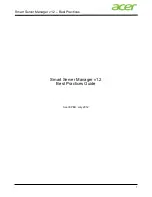
Crestron
e-control Mail SW-MAIL
35
••
Server Configuration In Depth
Installation & Reference Guide — Doc. 5798
Intersystem Communications
symbol). This option is checked in the figure above,
which means that the optional signals are forced to the following definitions:
Optional Signal
Send e-Mail
symbol value
SignalA
n
where
n
= 1 to:
3
SignalS
n
where
n
= 1 to:
3
SignalD
n
where
n
= 1 to:
10
PageFlip
defined
Status
defined
EchoDate, EchoSubj, EchoFrom,
and
EchoRcpt
defined
NewCount, OldCount
defined
ErrString, ErrNumber,
and
ErrTrigger
defined
None of these signals definitions can be altered so long as the
Using “Receive
e-Mail” SIMPL symbol
option is checked.
Referenced Signal Blocks
References to other signal blocks are optional. When given, they enhance the
functionality of the e-mailbox signal block, as described below.
IN Box scroller
Supplying a reference to a scroller here causes the signal block to download new
mail into the database table associated with the named scroller. This table serves as
an “IN box,” a repository for incoming e-mail.
If the
Process control messages
option is checked, only non-control messages will
end up in the IN box.
If an IN box scroller is not specified, non-control messages are ignored (and possibly
deleted from the server; see “Delete from Mail Server as downloaded,” below).
If the
Process control messages
option is not checked
and
an IN box scroller is not
referenced, the signal block configuration is considered invalid and attempting to
start the server protocol results in an error.
Message scroller
This table is required in order to display a message chosen from the IN box.
If it is not specified, the IN box scroller is still usable, but picking a message from
the scroller does not produce any visible result. Note, however, that picking a record
from the IN box scroller still responds with the
PageFlip
signal (if defined) and the
various
Echo
signals; and doing so still has utility for the
Delete
,
KeepAsNew,
and
Reply
signals.
Reply e-mailer
An e-mailer signal block is specified here to be used for replying to messages. If it is
not specified, the
Reply
signal results in a run-time error message. When an active
e-mailer signal block is properly specified here, the
Reply
signal prepares a new
outgoing e-mail message using the specified e-mailer signal block, as follows:
•
The recipient name and address of the new message is set to the sender’s name
(when available) and address from the present message.
















































